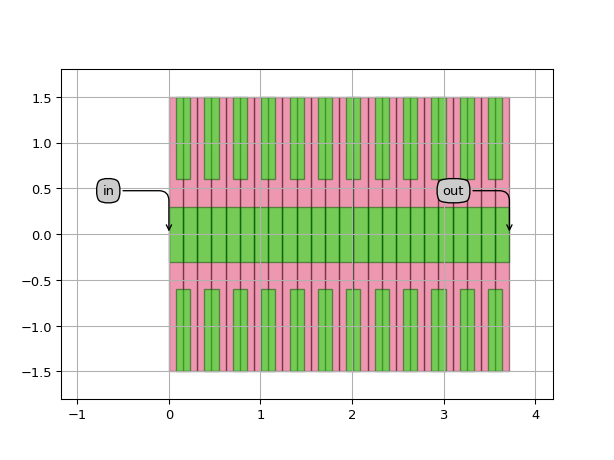WaveguideSideBlockGratingPeriod
- class picazzo3.wg.grating.cell.WaveguideSideBlockGratingPeriod
Period for a waveguide with blocks on the side. The base definition is taken from the wg_template which is used for the ports.
- Parameters:
- wg_template: PCell and _WaveguideTemplate
Waveguide template of start and end of the period (and ports)
- name: String that contains only ISO/IEC 8859-1 (extended ASCII py3) or pure ASCII (py2) characters
The unique name of the pcell
Views
- class Layout
- Parameters:
- block_layer: __Layer__
Layer on which the blocks should be drawn. By default, the core layer of the waveguide is used.
- relative_block_width: ( bool, bool_ or int )
If True, the block width is expressed as a fraction of the length.
- block_offset: float and Real, number and number >= 0
The offset from the waveguide center line to the block’s edge closest to the waveguide core. By default, the core width is used.
- block_height: float and number > 0
The height of the side block, perpendicular to the waveguide direction. By default, it extends up to the edge of the cladding.
- block_width: float and number > 0
The width of the block along the waveguide direction. If ‘relative_block_width’ is True (default), this is expressed as a fraction of the period length (fill factor).
- length: float and Real, number and number >= 0
Length of the grating period.
- view_name: String that contains only alphanumeric characters from the ASCII set or contains _$. ASCII set is extended on PY3.
The name of the view
Examples
"""We make a grating with blocks on the side.""" import si_fab.all as pdk # noqa: F401 from picazzo3.wg.grating import WaveguideUniformGrating, WaveguideSideBlockGratingPeriod from picazzo3.traces.wire_wg import WireWaveguideTemplate t1 = WireWaveguideTemplate(name="wire_t") t1.Layout(core_width=0.6, cladding_width=3.0) period = WaveguideSideBlockGratingPeriod(name="period_sb", wg_template=t1) period.Layout(length=0.31) # use defaults period.CircuitModel(reflection=0.2) grating = WaveguideUniformGrating(name="my_sideblock_grating", period_cell=period, n_o_periods=12) layout = grating.Layout() layout.visualize(annotate=True)
